Delphi › Herodotus » Ancient origins
Articles and Definitions › Contents
- Delphi › Ancient History
- Herodotus › Who Was
Ancient civilizations › Historical and archaeological sites
Delphi › Ancient History
Definition and Origins
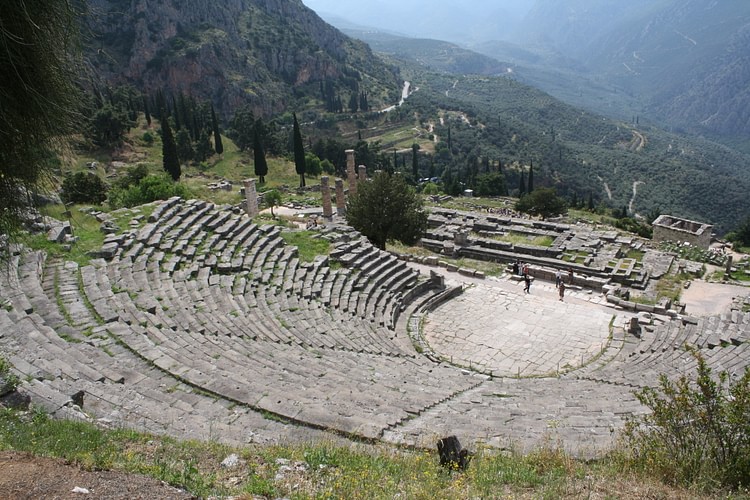
Delphi was an important ancient Greek religious sanctuary sacred to the god Apollo. Located on Mt. Parnassus near the Gulf of Corinth, the sanctuary was home to the famous oracle of Apollo which gave cryptic predictions and guidance to both city -states and individuals. In addition, Delphi was also home to the panhellenic Pythian Games.
MYTHOLOGY & ORIGINS
The site was first settled in Mycenaean times in the late Bronze Age (1500-1100 BCE) but took on its religious significance from around 800 BCE. The original name of the sanctuary was Pytho after the snake which Apollo was believed to have killed there. Votive offerings at the site from this period include small clay statues (the earliest), bronze figurines, and richly decorated bronze tripods.
FOR THE GREEKS DELPHI WAS CONSIDERED THE CENTRE OF THE WORLD.
Delphi was also considered the centre of the world, for in Greek mythology Zeus released two eagles, one to the east and another to the west, and Delphi was the point at which they met after encircling the world. This fact was represented by the omphalos (or navel), a dome-shaped stone which stood outside Apollo's temple and which also marked the spot where Apollo killed the Python.
APOLLO'S ORACLE
The oracle of Apollo at Delphi was famed throughout the Greek world and even beyond. The oracle - the Pythia or priestess - would answer questions put to her by visitors wishing to be guided in their future actions. The whole process was a lengthy one, usually taking up a whole day and only carried out on specific days of the year. First the priestess would perform various actions of purification such as washing in the nearby Castalian Spring, burning laurel leaves, and drinking holy water. Next an animal - usually a goat - was sacrificed. The party seeking advice would then offer a pelanos - a sort of pie - before being allowed into the inner temple where the priestess resided and gave her pronouncements, possibly in a drug or natural gas-induced state of ecstasy.
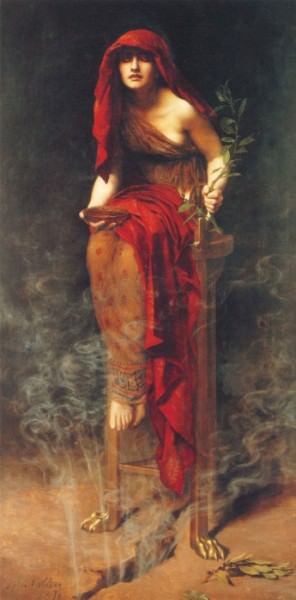
Pythia of the Oracle of Delphi
Perhaps the most famous consultant of the Delphic oracle was Croesus, the fabulously rich King of Lydia who, faced with a war against the Persians, asked the oracle's advice. The oracle stated that if Croesus went to war then a great empire would surely fall. Reassured by this, the Lydian king took on the mighty Cyrus. However, the Lydians were routed at Sardis and it was the Lydian empire which fell, a lesson that the oracle could easily be misinterpreted by the unwise or over-confident.
PANHELLENIC GAMES
Delphi, as with the other major religious sites of Olympia, Nemea, and Isthmia, held games to honour various gods of the Greek religion. The Pythian Games of Delphi began sometime between 591 and 585 BCE and were initially held every eight years, with the only event being a musical competition where solo singers accompanied themselves on a kithara to sing a hymn to Apollo. Later, more musical contests and athletic events were added to the programme, and the games were held every four years with only the Olympic Games being more important. The principal prize for victors in the Games was a crown of laurel or bay leaves.
The site and games were managed by the independent Delphic amphictiony - a council with representatives from various nearby city-states - which levied taxes, collected offerings, invested in construction programmes, and even organised military campaigns in the Four Sacred Wars, fought to redress sacrilegious acts against Apollo perpetrated by the states of Crisa, Phocis, and Amphissa.
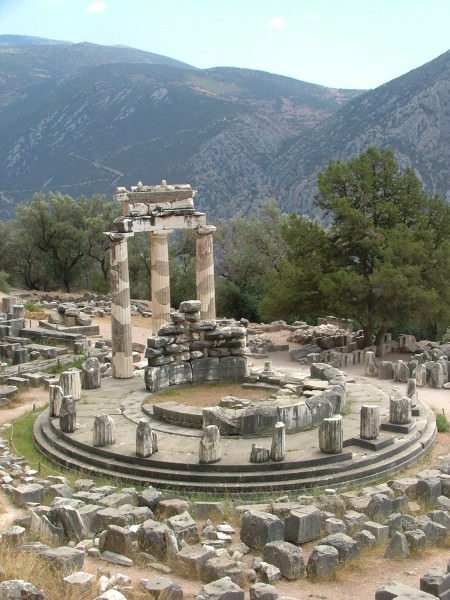
Tholos of Delphi
ARCHITECTURE
The first temple in the area was built in the 7th century BCE and was itself a replacement for less substantial buildings of worship which had stood before it. The focal point of the sanctuary, the Doric temple of Apollo, was unfortunately destroyed by fire in 548 BCE. A second temple, again Doric in style, was completed in c. 510 BCE with the help of the exiled Athenian family, the Alcmeonids. Measuring some 60 by 24 metres, the facade had six columns whilst the sides had 15. This temple was destroyed by earthquake in 373 BCE and was replaced by a similarly proportioned temple in 330 BCE. This was constructed with poros stone coated in stucco. Marble sculpture was also added as decoration along with Persian shields taken at the Battle of Marathon. This is the temple which survives, albeit only partially, today.
Other notable constructions at the site were the theatre (with capacity for 5,000 spectators), temples to Athena (4th century BCE), a tholos with 13 Doric columns (c. 580 BCE), stoas, stadium (with capacity for 7,000 spectators), and around 20 treasuries, which were constructed to house the votive offerings and dedications from city-states all over Greece. Similarly, monuments were also erected to commemorate military victories and other important events. For example, the Spartan general Lysander erected a monument to celebrate his victory over Athens at Aegospotami. Other notable monuments were the great bronze Bull of Corcyra (580 BCE), the ten statues of the kings of Argos (c. 369 BCE), a gold four-horse chariotoffered by Rhodes, and a huge bronze statue of the Trojan Horse offered by the Argives (c.413 BCE). Lining the sacred way, which wound from the sanctuary gate up to the temple of Apollo, the visitor must have been greatly impressed by the artistic and literal wealth on display. Alas, in most cases, only the monumental pedestals survive of these great statues, silent witnesses to a lost grandeur.
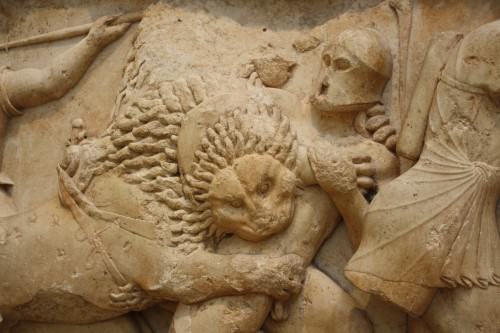
Gigantomachy of Delphi
DEMISE
In 480 BCE the Persians attacked the sanctuary and in 279 BCE the sanctuary was again attacked, this time by the Gauls. It was during the 3rd century BCE that the site came under the control of the Aitolian League. In 191 BCE Delphi passed into Roman hands; however, the sanctuary and the games continued to be culturally important in Roman times, in particular under Hadrian. The decree by Theodosius in 393 CE to close all pagan sanctuaries resulted in Delphi's gradual decline. A Christian community dwelt at the site for several centuries until its final abandonment in the 7th century CE.
The site was 're-discovered' with the first modern excavations being carried out in 1880 CE by a team of French archaeologists. Notable finds were splendid metope sculptures from the treasury of the Athenians (c. 490 BCE) and the Siphnians (c. 525 BCE) depicting scenes from Greek mythology. In addition, a bronze charioteer in the severe style (480-460 BCE), the marble Sphinx of the Naxians (c. 560 BCE), the twin marble archaic statues - the kouroi of Argos (c. 580 BCE) and the richly decorated omphalos stone (c. 330 BCE) - all survive as testimony to the cultural and artistic wealth that Delphi had once enjoyed.
The site was 're-discovered' with the first modern excavations being carried out in 1880 CE by a team of French archaeologists. Notable finds were splendid metope sculptures from the treasury of the Athenians (c. 490 BCE) and the Siphnians (c. 525 BCE) depicting scenes from Greek mythology. In addition, a bronze charioteer in the severe style (480-460 BCE), the marble Sphinx of the Naxians (c. 560 BCE), the twin marble archaic statues - the kouroi of Argos (c. 580 BCE) and the richly decorated omphalos stone (c. 330 BCE) - all survive as testimony to the cultural and artistic wealth that Delphi had once enjoyed.
MAP
Herodotus › Who Was
Definition and Origins
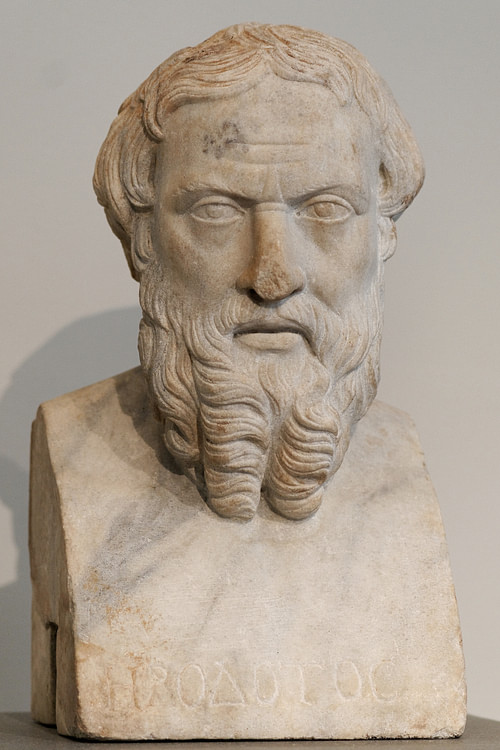
Herodotus (c. 484 – 425/413 BCE) was a Greek writer who invented the field of study known today as `history'. He was called `The Father of History' by the Roman writer and orator Cicero for his famous work The Histories but has also been called “The Father of Lies” by critics who claim these `histories' are little more than tall tales.
RELIABILITY
Criticism of Herodotus' work seems to have originated among Athenians who took exception to his account of the Battle of Marathon (490 BCE) and, specifically, which families were due the most honor for the victory over the Persians. More serious criticism of his work has to do with the credibility of the accounts of his travels.
One example of this is his claim of fox-sized ants in Persia who spread gold dust when digging their mounds. This account has been rejected for centuries until, in 1984 CE, the French author and explorer Michel Peissel, confirmed that a fox-sized marmot in the Himalayas did indeed spread gold dust when digging and that accounts showed the animal had done so in antiquity as the villagers had a long history of gathering this dust.
HERODOTUS MOVES FLUIDLY THROUGH HIS WORK FROM CULTURE TO CULTURE & IS ALWAYS MOST INTERESTED IN TELLING A GOOD STORY.
Peissel also explains that the Persian word for `mountain ant' was very close to their word for `marmot' and so it was established that Herodotus was not making up his giant ants but, since he did not speak Persian and had to rely on translators, was the victim of a misunderstanding in translation. This same scenario could apply to other observations and claims found in Herodotus' histories though, certainly, not all. In the interests of telling a good story, Herodotus sometimes indulged in speculation and, at other times, repeated stories he had heard as though they were his own experiences.
EARLY LIFE & TRAVELS
While little is known of the details of his life, it seems certain that he came from a wealthy, aristocratic family in Asia Minor who could afford to pay for his education. His skill in writing is thought to be evidence of a thorough course in the best schools of his day. He wrote in Ionian Greek and was clearly well read. His ability to travel, seemingly at will, also argues for a man of some means. It is thought he served in the army as a Hoplite in that his descriptions of battle are quite precise and always told from the point of view of a foot soldier.
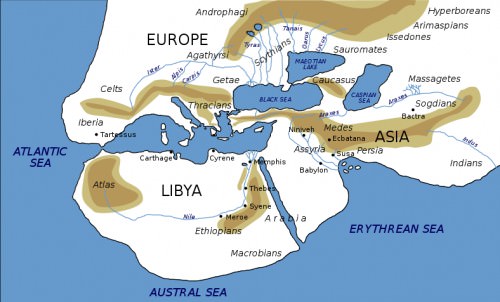
World Map of Herodotus
Scholar Robin Waterfield comments on Herodotus' early life:
Herodotus was not a native of Athens. He was born in Halicarnassus (the modern Turkish city of Bodrum), about the time of the Persian Wars. Halicarnassus was a Dorian town with substantial intermarriage among its Greek, Carian, and Persian populations...If the later ancient reports that have come down to us are correct, his family was exiled during the troubled years after the Persian Wars, and as a very young man Herodotus may have lived on the island of Samos. His occasional comments in the Histories show us that he travelled widely around the world of the east Mediterranean. We do not know when and how the Histories were first written down;very likely, however, they arose out of recitations or readings that he gave over a number of years in other Greek cities and in Athens at the height of its imperial power. (x)
HERODOTUS' PENCHANT FOR STORYTELLING, & HIS OBVIOUS TALENT FOR IT, HAVE ALARMED & ANNOYED CRITICS SINCE ANTIQUITY.
If Waterfield is correct, Herodotus' early experience with travel would have shaped his later inclinations; he does not seem to have stayed in any one place very long. He moves fluidly through his work from culture to culture and is always most interested in telling a good story and less so with fact-checking the details of the tales he heard and repeats in his pages. It is this tendency of his, as noted, which has given rise to the centuries of criticism against him.
THE HISTORIES
While it is undeniable that Herodotus makes some mistakes in his work, his Histories are generally reliable and scholarly studies in all disciplines concerning his work (from archaeology to ethnology and more) have continued to substantiate all of his most important observations.
Herodotus identifies himself in the prologue to his work as a native of Halicarnassus (on the south-west coast of Asia Minor, modern Turkey ) and this is accepted as his birthplace even though Aristotle and the Suda claim he was a native of Thurii.This discrepancy is generally understood as a mistake made in an ancient source (possibly a translation of Herodotus' work) as Herodotus may have lived on the island of Thurii but had not been born there.
He traveled widely in Egypt, Africa and Asia Minor and wrote down his experiences and observations, providing later generations with detailed accounts of important historical events (such as the Battle of Marathon in 490 BCE and Thermopylae and Salamis in 480 BCE) everyday life in Greece, in Egypt, in Asia Minor and on The Seven Wonders of the Ancient world. His description of The Walls of Babylon as among these wonders is an example of why his work has often been criticized. Herodotus writes:
Babylon lies in a great plain, and in size it is such that each face measures 22½ km, the shape of the whole being square; thus the circumference is 90 km. Such is the size of the city of Babylon, and it has magnificence greater than all other cities of which we have knowledge. First there runs round it a deep and broad trench, full of water; then a wall fifty meters in thickness and hundred meters in height [...]. At the top of the wall along the edges they built chambers of one story facing one another; and between the rows of chambers they left space to drive a four-horse chariot. In the circuit of the wall there are set a hundred gates made of bronze. ( Histories, I.178-179)
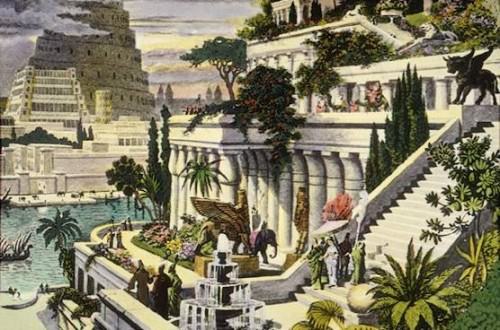
Hanging Gardens of Babylon
Archaeological evidence, as well as other ancient descriptions, clearly indicates that Babylon was not as large as Herodotus describes and had nowhere near 100 gates (it had only eight). It has thus been determined that this account was based on hearsay, rather than a personal visit, even though Herodotus writes as though he visited the site himself. As he had a great appreciation for the works of Homer (he bases the arrangement of his Histories on Homer's form) his passage on Babylon is thought to be emulating the earlier writer's description of Egyptian Thebes.
His penchant for storytelling, and his obvious talent for it, have alarmed and annoyed critics since antiquity but this very quality in the Histories is also what has made the work so greatly admired. Herodotus is able to bring a reader into the events of the stories he relates by creating vivid scenes with interesting characters and, sometimes, even dialogue.
He was hardly an impartial observer of the world he wrote about and often gives personal opinions at length on various people, customs, and events. While his admiration for Homer is always evident, he freely questioned the historical truth of The Iliad, asking why the Achaeans would wage so lengthy and costly a campaign as the Trojan War on behalf of one woman. This is only one of many examples of Herodotus' personality displaying itself in his work. Waterfield comments:
Certain kinds of narrative recur strikingly enough [in the Histories ] to make us feel we are seeing the idiosyncratic taste of the narrator emerging - that he enjoys a particular kind of story and, given the option, includes it when possible. Herodotus is fascinated by the interplay of nature and culture; the Scythians, living in a treeless land, invent a way of cooking meat in which the animal's bones and fat provide the fire and the stomach provides the pot in which the meat is cooked (4.61). He also singles out clever individuals and great achievements; he enjoys noting the `first inventor' of something, or a particularly striking building, or boat, or custom, or other cultural achievement. (xxxviii)
Herodotus personality, in fact, comes through quite often in the pages of his works. A reader understands that one is hearing from an individual with certain tastes and interests and that the author considers that what he has to say is important enough to require no explanation, qualification, or apology for perceived inaccuracy; if Herodotus felt like including something, he would include it and he never seems to care if readers find fault with that practice.
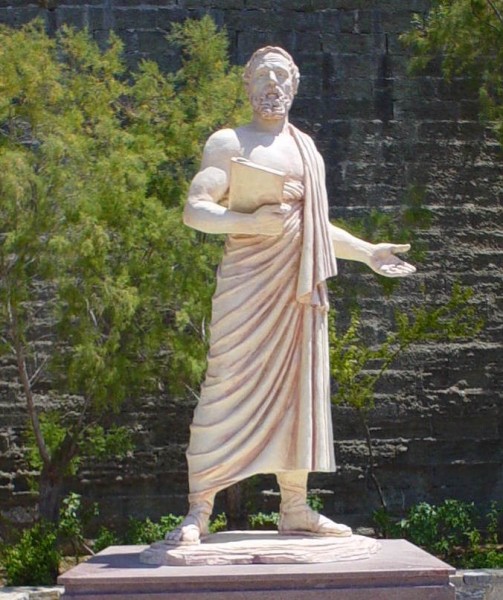
Herodotus of Halicarnassos
HERODOTUS IN THE HISTORIES
That he held himself in quite high regard is apparent in the prologue to the Histories which begins,
These are the researches of Herodotus of Halicarnassus, which he publishes, in the hope of thereby preserving from decay the remembrance of what men have done, and of preventing the great and wonderful actions of the Greeks and the Barbarians from losing their due meed of glory; and withal to put on record what were their grounds of feuds (I.1).
HERODOTUS ONCE REFUSED TO READ HIS BOOK TO A CROWD UNTIL THERE WAS AMPLE CLOUD COVER TO SHADE HIM ON THE PLATFORM.
Unlike other ancient writers (such as Homer, earlier, or Virgil, later), Herodotus does not attribute his narrative to divine sources, nor call on such for assistance, but announces clearly that this is his work and no others. His high opinion of himself is also displayed in what is recorded as the first `publication' of the Histories at the Olympic Games.
Works at this time were `published' by being read aloud and the Greek writer Lucian of Samosata (125-180 CE) claims that Herodotus read the entirety of his work to the audience in one sitting and received great applause. Another version of the publication of the work, however, claims that Herodotus refused to read his book to the crowd until there was ample cloud cover to shade him on the platform. While he waited, the audience left, and this event is what gave rise to the maxim, “Like Herodotus and his shade” alluding to one who misses an opportunity by waiting for optimal circumstances. Whichever account is true, if either is, they both reflect the esteem Herodotus was known to hold himself in.
LATER LIFE & DEATH
After travelling the world of his time, Herodotus came to live in the Greek Colony of Thurii, in Italy, where he edited and revised the Histories later in life. He had also lived in Athens and, at some point, it is thought he returned there. Scholars consider it likely that he died in Athens of the same plague that killed Athenian statesman Pericles (l. 495-429 BCE) sometime between 425 and 413 BCE.
His fame was so great that many different cities (Athens and Thurii among them) claimed to be the site of his funeral and grave and monuments were erected in his honor. The lasting significance of his work continues to be appreciated by millions of people today and he is considered a primary source for reliable information on the ancient world he observed and wrote about.
LICENSE:
Article based on information obtained from these sources:with permission from the Website Ancient History Encyclopedia
Content is available under License Creative Commons: Attribution-NonCommercial-ShareAlike 3.0 Unported. CC-BY-NC-SA License